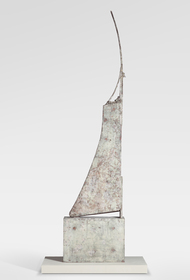
View of the sixth-floor Whitney terrace: Tony Smith, ‘Die’, 1962, steel, Whitney Museum of American Art, New York; purchased with funds from the Louis and Bessie Adler Foundation, Inc., James Block, The Sondra and Charles Gilman Jr. Foundation, Inc., Penny and Mike Winton, and the Painting and Sculpture Committee; and Robert Morris, untitled (3 Ls), 1965, (refabricated 1970), stainless steel, Whitney Museum of American Art, New York; Gift of Howard and Jean Lipman). Photo by Ken Carpenter.
The New York art scene was marked by a number of remarkable events this spring, and some important, worrisome issues came to the fore.
First, the auctions. There were four major previews on one day, Sunday May 10, with Sotheby’s and Christies offering brunches to their preferred customers: Pol Roget champagne, smoked salmon, quail-egg canapés and so on. Armed guards in special rooms with limited access to the big-ticket items underlined their importance. Heightened sales promotion does pay off. The $179m for what I take to be a rather undistinguished Picasso, Les femmes d’Algier, Version O (1955), was the largest sum ever paid at auction for a work of art, and a good, life-size Giacometti, L’Homme au Doigt (1947), set a record for a sculpture sold at auction, going for $141m. Rothko’s No. 10 (1958) went for $82.9m, just short of the record for that artist. Warhol seems to have retained his high-end status. Christopher Wool’s Untitled (Riot) (1990) went for an improbable $29.9m, a record for that artist, and what I take to be an undistinguished work by Robert Ryman, Bridge (1980), set an equally surprising record for him too at $20.6m. The auctions were a striking reminder that we are in a new and disturbing age of income inequality. If the buyer of the Picasso wanted to limit his cost to just one per cent of his wealth, his net worth would be $17.9 billion, However, according to Bloomberg, one underbidder did offer 3.7% of his wealth, so perhaps $17.9 billion is too high an estimate. Whatever the case, the implications are enormous. French economist Thomas Piketty has suggested new taxes on financial transactions and on wealth, but none are in sight. In the mean time, the new super rich class has found an attractive alternative store of value for their assets, although one has to wonder how stable it is. Will Warhol turn out to be the Meisonnier of our time, suffering an equally precipitous decline in favour? More importantly, to what extent has branding come to determine market value for art, and how much has artistic quality lost out as a value in and of itself? How much have the priorities of the advertising giants infected not only collectors but also the museums? Enthusiasts for Damien Hirst, Jeff Koons and the like will not be concerned, but others will be.
On the first of May the Whitney Museum of American Art opened its spacious new building designed by Renzo Piano and located close to the Hudson River at the south end of High Line Park. It has many strong features, one being the numerous good-sized outdoor terraces with engaging views of the River and Park, as well as comfortable seating and extensive space for such iconic sculptures as Tony Smith’s Die (1962) and David Smith’s Cubi XX1 (1964).
(more…)

